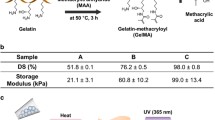Abstract
A novel type of porous scaffold was fabricated from single protein nanogels. The nanogels with single protein as core and crosslinked polymer network as shell were prepared through a two-step procedure including surface acryloylation and in situ radical polymerization. The formation of single protein nanogels was verified by matrix assisted laser desorption/ionization time-of-flight (MALDI-TOF) mass spectrometer, transmission electron microscopy (TEM) and dynamic light scattering (DLS) analyses. Subsequently, the porous scaffolds were fabricated through a solvent evaporating process of aqueous nanogel solutions. The porous scaffolds were characterized by Fourier transform infrared (FTIR), scanning electronic microscopy (SEM), atomic force microscopy (AFM), and fluorescence microscopy. Interestingly, the obtained porous nanogel scaffolds presented multi-level porous morphologies with macro and nano scale pores, providing better spaces and microenvironments than normal macro porous scaffolds. Cell proliferation assay of nanogels showed low cytotoxicity. Considering that both the protein species and polymer constitutes can be pre-designed and adjusted, these multi-level porous nanogel scaffolds are promising candidates for tissue culture applications.
Similar content being viewed by others
References
Kim HJ, Kim UJ, Vunjak-Novakovicc G, Minb BH, Kaplan DL. Influence of macroporous protein scaffolds on bone tissue engineering from bone marrow stem cells. Biomaterials, 2005, 26: 4442–4452
Mandal BB, Kundu SC. Non-bioengineered silk fibroin protein 3D scaffolds for potential biotechnological and tissue engineering applications. Macromol Biosci, 2008, 8: 807–818
Wang Y, Kim HJ, Vunjak-Novakovic G, Kaplan DL. Stem cell-based tissue engineering with silk biomaterials. Stem cell-based tissue engineering with silk biomaterials. Biomaterials, 2006, 27: 6064–6082
Wang Y, Blasioli DJ, Kim HJ, Kim HS, Kaplan DL. Cartilage tissue engineering with silk scaffolds and human articular chondrocytes. Biomaterials, 2006, 27: 4434–4442
Vepari C, Kaplan DL. Silk as a biomaterial. Prog Polym Sci, 2007, 32: 991–1007
Meinel L, Hofmann S, Karageorgiou V, Zichner L, Langer R, Vunjak-Novakovic G, Kaplan DL. Engineering cartilage-like tissue using human mesenchymal stem cells and silk protein scaffolds. Biotechnol Bioeng, 2004, 88: 379–391
Altman GH, Diaz F, Jakuba C, Calabro T, Horan RL, Chen J, Lu H, Richmond J, Kaplan DL. Silk-based biomaterials. Biomaterials, 2003, 24: 401–416
Mann BK, Gobin AS, Tsai AT, Schmedlen RH, West JL. Smooth muscle cell growth in photopolymerized hydrogels with cell adhesive and proteolytically degradable domains: synthetic ECM analogs for tissue engineering. Biomaterials, 2001, 22: 3045–3051
Sales VL, Engelmayr GC, Johnson JA, Gao J, Wang YD, Sacks MS, Mayer JE. Protein precoating of elastomeric tissue-engineering scaffolds increased cellularity, enhanced extracellular matrix protein production, and differentially regulated the phenotypes of circulating endothelial progenitor cells. Circulation, 2007, 9: I59–I63
Zhu HG, Ji J, Barbosa MA, Shen JC. Osteoblast growth promotion by protein electrostatic self-assembly on biodegradable poly(lactide). J Biomater Sci, Polym Ed, 2005, 16(6): 761–774
Levenberg S, Huang NF, Lavik E, Rogers AB, Itskovitz-Eldor J, Langer R. Differentiation of human embryonic stem cells on three-dimensional polymer scaffolds. PNAS, 2003, 100(22): 12741–12746
Nair A, Thevenot P, Dey J, Shen JH, Sun MW, Yang J, Tang LP. Novel polymeric scaffolds using protein microbubbles as porogen and growth factor carriers. Tissue Eng: Part C, 2009, 15(0): 1–10
Zhang YF, Cheng XR, Wang JW, Wang YN, Shi B, Huang C, Yang XC, Liu TJ. Novel chitosan/collagen scaffold containing transforming growth factor-b1 DNA for periodontal tissue engineering. Biochem Biophys Res Commun, 2006, 344: 362–369
Miko AG, Sarakinos G, Vacanti JP, Langer RS, Cima LG. Biocompatible polymer membranes and method of preparation of the three dimensional membrane structure. US Patent No. 5, 514378; 1996
Wray LS, Orwin EJ. Recreating the microenvironment of the native cornea for tissue engineering applications. Tissue Eng: Part A, 2009, 15(7): 1463–1472
Gelain F, Bottai D, Vescovi A, Zhang SG. Designer self-assembling peptide nanofiber scaffolds for adult mouse neural stem cell 3-dimensional cultures. PLoS ONE, 2006, 1(e119): 1–11
Yan M, Ge J, Liu Z, Ouyang PK. Encapsulation of single enzyme in nanogel with enhanced biocatalytic activity and stability. J Am Chem Soc, 2006, 128: 11008–11009
Yan M, Du JJ, Gu Z, Liang M, Hu YF, Zhang WJ, Priceman S, Wu L, Hong Z, Liu Z, Segura T, Tang Y, Lu YF. A novel intracellular protein delivery platform based on single-protein nanocapsules. Nature Nanotech, 2010, 5: 48–53
Du JJ, Yu CM, Pan DC, Li JM, Chen W, Yan M, Segura T, Lu YF. Quantum-dot-decorated robust transductable bioluminescent nanocapsules. J Am Chem Soc, 2010, 132: 12780–12781
Vacanti JP, Langer R. Tissue engineering: The design and fabrication of living replacement devices for surgical reconstruction and transplantation. Lancet, 1999, 354(Suppl. 1): SI32–34
Dvir T, Timko BP, Kohane DS, Langer R. Nanotechnological strategies for engineering complex tissues. Nature Nanotech, 2011, 6: 13–22
Author information
Authors and Affiliations
Corresponding authors
Rights and permissions
About this article
Cite this article
Zhu, Q., Yan, M., He, L. et al. Fabrication of porous scaffolds with protein nanogels. Sci. China Chem. 54, 961–967 (2011). https://doi.org/10.1007/s11426-011-4276-0
Received:
Accepted:
Published:
Issue Date:
DOI: https://doi.org/10.1007/s11426-011-4276-0




